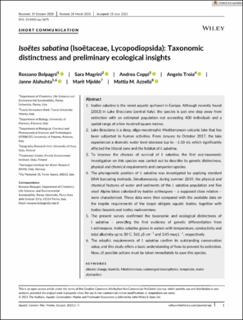| dc.description.abstract | Isoëtes sabatina is the rarest aquatic quillwort in Europe. Although recently found (2013) in Lake Bracciano (central Italy), the species is just one step away from extinction with an estimated population not exceeding 400 individuals and a spatial range of a few hundred square metres. Lake Bracciano is a deep, oligo-mesotrophic Mediterranean volcanic lake that has been subjected to human activities. From January to October 2017, the lake experienced a dramatic water level decrease (up to −1.50 m), which significantly affected the littoral zone and the habitat of I. sabatina. To improve the chances of survival of I. sabatina, the first eco-taxonomic investigation on this species was carried out to describe its genetic distinctness, physical and chemical requirements and companion species. The phylogenetic position of I. sabatina was investigated by applying standard DNA barcoding methods. Simultaneously, during summer 2019, the physical and chemical features of water and sediments of the I. sabatina population and five small Alpine lakes colonized by Isoëtes echinospora – a supposed close relative – were characterized. These data were then compared with the available data on the trophic requirements of the target obligate aquatic Isoëtes, together with Isoëtes lacustris and Isoëtes malinverniana. The present survey confirmed the taxonomic and ecological distinctness of I. sabatina – providing the first evidence of genetic differentiation from I. echinospora. Isoëtes sabatina grows in waters with temperature, conductivity and total alkalinity up to 30°C, 561 μS cm−1 and 3.45 meq L−1, respectively. The edaphic requirements of I. sabatina confirm its outstanding conservation value, and this study offers a basic understanding of how to prevent its extinction. Now, all possible actions must be taken immediately to save this species. | |

